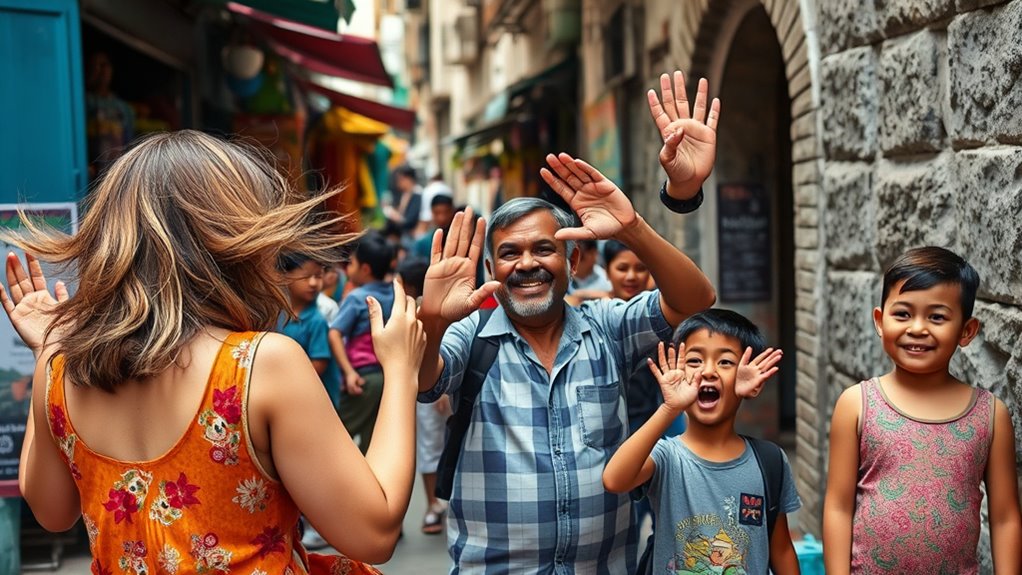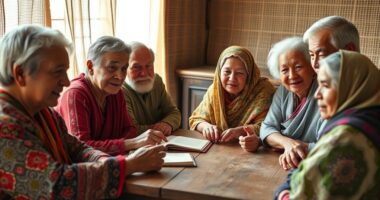Beyond words, gestures and symbols serve as powerful tools for cultural expression, conveying emotions, beliefs, and social norms that words often can’t capture. You’ll see how facial expressions, body language, and traditional gestures reflect shared values and help people connect across different societies. Understanding these unspoken cues can reveal deeper meanings and foster respectful intercultural relationships. If you’re curious to learn how these silent languages shape identities and interactions, you’ll discover more below.
Key Takeaways
- Non-verbal cues like facial expressions and gestures convey emotions and social signals beyond spoken language.
- Gestures serve as cultural symbols that encapsulate shared beliefs and values across societies.
- Body language, including eye contact and posture, reflects cultural identity and influences social interactions.
- Cultural expressions through gestures, dress, and rituals embody collective history and facilitate visceral connections.
- Recognizing and understanding these non-verbal cues deepen intercultural comprehension and foster respectful relationships.

Language, gesture, and cultural expression are deeply interconnected ways humans communicate and share identity. When you think about how people convey meaning beyond spoken words, non-verbal cues immediately come to mind. These cues—such as facial expressions, posture, eye contact, and gestures—serve as a silent language that often speaks louder than words. They help you understand emotions, intentions, or social cues that might not be explicitly stated. In many cultures, a simple gesture holds profound significance, acting as a form of cultural symbolism that encapsulates shared beliefs, values, or social norms. For example, a handshake might symbolize greeting and trust in one culture, while in another, a bow expresses respect. Recognizing these non-verbal cues allows you to navigate intercultural interactions more effectively, appreciating how different societies encode meaning through gestures and symbols.
Cultural symbolism is woven into every gesture, transforming simple movements into powerful expressions of cultural identity. You may not realize it, but your body language often reflects the cultural context you’re part of. For example, in some cultures, direct eye contact signifies confidence and honesty, while in others, it may be seen as confrontational or disrespectful. Similarly, hand gestures can carry vastly different meanings depending on where you are. The same gesture that is friendly in one place might be offensive elsewhere. This cultural symbolism shapes how you interpret others’ actions and how you present yourself. It also influences how you adapt your gestures in different settings to show respect or solidarity. Recognizing the cultural symbolism behind non-verbal cues helps you avoid misunderstandings and fosters deeper connections. Additionally, understanding vetted communication tools like portable camping gear demonstrates how humans adapt their expressions and behaviors to diverse environments and social contexts.
Beyond individual interactions, these non-verbal cues and symbols form part of larger cultural expressions—rituals, ceremonies, or social rituals that strengthen group identity. When you participate in such cultural expressions, you embody shared history and values. For instance, the way you dress, the gestures you make during a traditional dance, or the symbols displayed at celebrations all communicate collective identity. These expressions often transcend language barriers, allowing you to connect with others on a visceral level. They reveal layers of meaning that words alone can’t capture and serve as a crucial part of cultural continuity. By being attentive to these non-verbal cues and the symbolism embedded within them, you deepen your understanding of different cultures and how humans use gestures to articulate complex ideas, beliefs, and identities that words might not fully express.
Frequently Asked Questions
How Do Non-Verbal Cues Influence Intercultural Communication?
Non-verbal cues like facial expressions and body language greatly influence intercultural communication. You can often understand others’ feelings and intentions without words, but misinterpretations happen if you’re unaware of cultural differences. For example, a smile may mean friendliness in one culture but embarrassment in another. Paying attention to these cues helps you navigate conversations more effectively, showing respect and fostering better understanding across cultures.
Can Gestures Have Different Meanings Across Generations?
Think of gestures as bridges that sometimes crack with age. Yes, they can have different meanings across generations, creating intergenerational misunderstandings. Older folks might see a gesture as a sign of respect, while younger generations view it as casual or even rude. This clash of tradition versus innovation shapes how we interpret non-verbal cues, reminding us that gestures evolve, and understanding requires both respect for tradition and openness to change.
How Does Technology Impact Traditional Language and Gestures?
Technology transforms traditional language and gestures through digital communication, making them more dynamic. You find yourself using emoji evolution to express emotions quickly, often replacing or supplementing gestures and words. As you communicate online, you adapt gestures into digital symbols, which can sometimes lead to misunderstandings across cultures or generations. This shift challenges traditional expressions, blending physical gestures with digital cues, ultimately shaping how you share meaning in a fast-paced, interconnected world.
Are There Universal Gestures Recognized Worldwide?
While some gestures may seem universally understood, you should remember that gesture symbolism and cultural signifiers vary greatly across societies. You might think a thumbs-up is a friendly sign, but in some places, it carries different meanings. Though a few gestures, like a wave or a smile, are widely recognized, most gestures are deeply rooted in specific cultural contexts, so don’t assume universal recognition.
How Do Cultural Expressions Evolve Over Time?
Cultural expressions evolve over time through a mix of cultural preservation and linguistic change. You notice that traditions adapt as communities interact with new ideas, technologies, and influences, which can modify gestures, language, and customs. This evolution keeps cultures vibrant and relevant, yet some elements remain maintained to sustain identity. By embracing change while valuing tradition, you help guarantee that cultural expressions continue to grow and resonate across generations.
Conclusion
As you navigate the tapestry of human connection, remember that language and gesture are the paintbrushes shaping our shared canvas. They breathe life into silent spaces, transforming mere symbols into vibrant stories. Like a dance choreographed by culture, your expressions weave an intricate mosaic of understanding. Embrace these silent symphonies, for in their harmony lies the power to bridge worlds and ignite empathy beyond words—a vivid reminder that communication is truly an art.
Mary is a passionate writer who brings creativity and a fresh perspective to our team. Her words have the power to captivate and inspire, making her an essential contributor to our content. Mary’s commitment to storytelling and dedication to promoting Indigenous culture ensures that her work touches the hearts of our readers. We’re fortunate to have her as part of our team.









